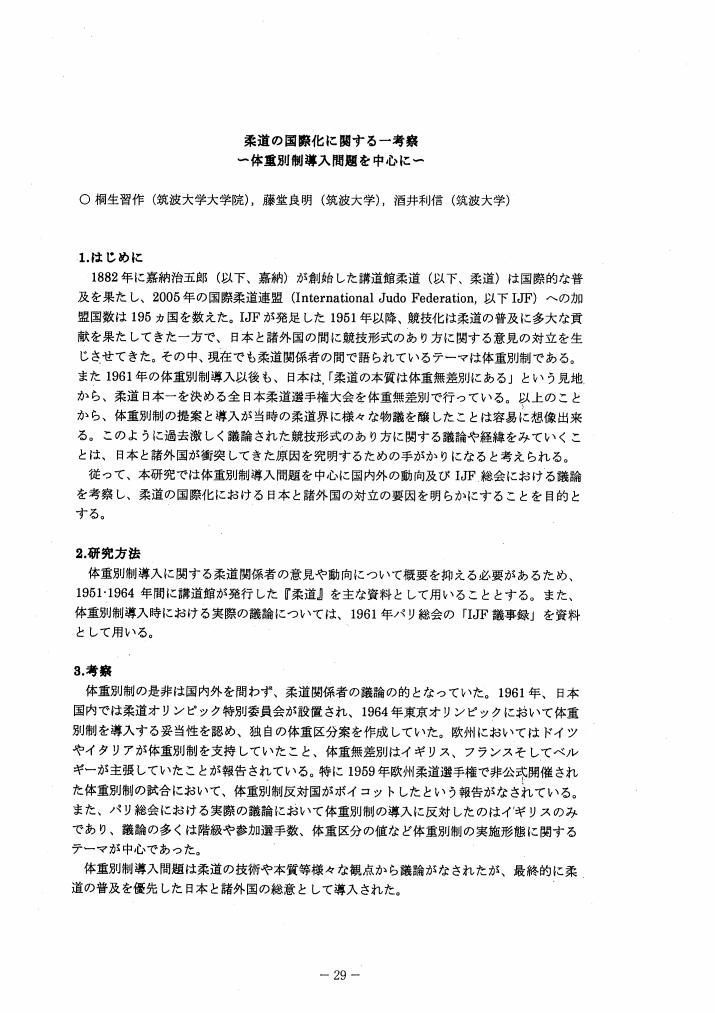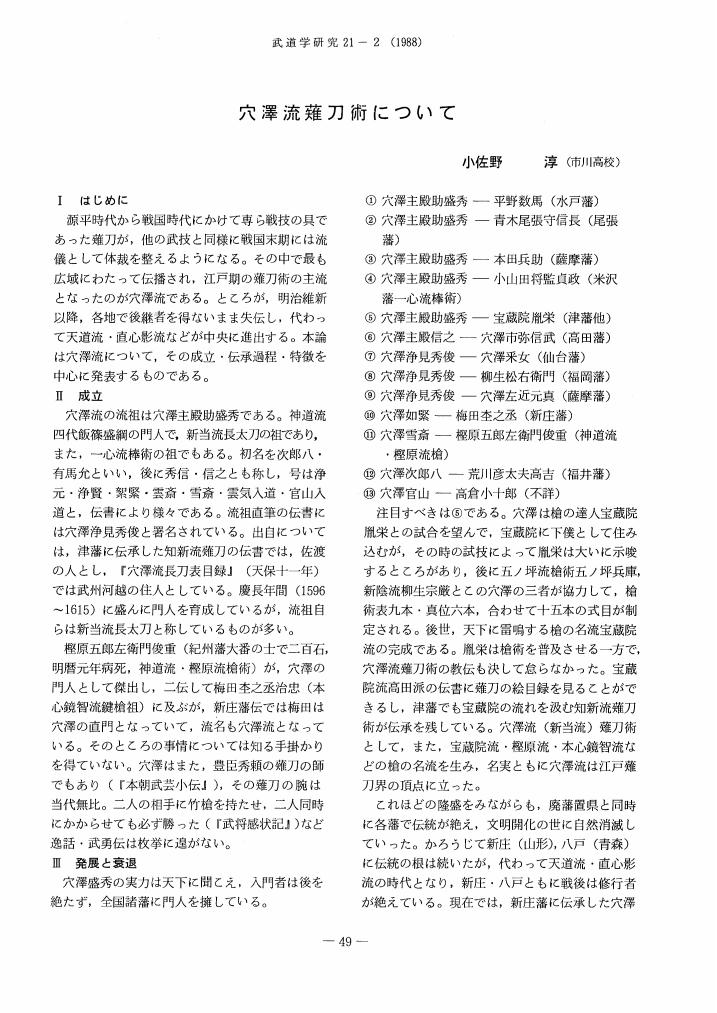1 0 0 0 OA 幕末期熊本藩における剣術の動向について(II)
- 著者
- 長尾 進
- 出版者
- 日本武道学会
- 雑誌
- 武道学研究 (ISSN:02879700)
- 巻号頁・発行日
- vol.24, no.2, pp.17-18, 1991 (Released:2012-11-27)
1 0 0 0 OA 左射法についての考察
- 著者
- 関根 令夫 森 俊男
- 出版者
- 日本武道学会
- 雑誌
- 武道学研究 (ISSN:02879700)
- 巻号頁・発行日
- vol.36, no.Supplement, pp.49, 2003 (Released:2012-11-27)
1 0 0 0 OA イランにおける空手道事情
- 著者
- 大下 正孝
- 出版者
- 日本武道学会
- 雑誌
- 武道学研究 (ISSN:02879700)
- 巻号頁・発行日
- vol.42, no.Supplement, pp.11, 2009 (Released:2012-08-28)
- 被引用文献数
- 1
1 0 0 0 Japan─神とともに歩んできた国
- 著者
- 鹿島 則良
- 出版者
- 日本武道学会
- 雑誌
- 武道学研究 (ISSN:02879700)
- 巻号頁・発行日
- vol.46, no.3, pp.119-126, 2014
1 0 0 0 OA 剣道の防御における時間的研究
- 著者
- 恵土 孝吉 星川 保
- 出版者
- 日本武道学会
- 雑誌
- 武道学研究 (ISSN:02879700)
- 巻号頁・発行日
- vol.16, no.3, pp.31-39, 1984-03-30 (Released:2012-11-27)
- 参考文献数
- 24
The purpose of this study is to measure a duration required for defense and furthermore, to investigate the factors which govern an achievement of defense in Kendo.Eleven University Kendo players were employed as subjects. Action potential from biceps brachii and triceps brachii of the right arm and a strain of shinai generated at strike were recorded. Time elapsed from initiation of action potential up to the strain of shinai is regarded as duration for defense. There is no difference in the duration required for defense due to the level of skill. Therefore it is supposed that there are more important factors than duration of defense action as to the achievement of defense in Kendo.
1 0 0 0 OA 柔道の国際化に関する一考察
1 0 0 0 OA 穴澤流薙刀術について
- 著者
- 小佐野 淳
- 出版者
- 日本武道学会
- 雑誌
- 武道学研究 (ISSN:02879700)
- 巻号頁・発行日
- vol.21, no.2, pp.49-50, 1988-11-30 (Released:2012-11-27)
- 参考文献数
- 2
1 0 0 0 OA 歩射本来の射術を生かした新競技方法の開発について
1 0 0 0 OA 和弓における「弓返り」に関する一考察
- 著者
- 井出 敦夫
- 出版者
- 日本武道学会
- 雑誌
- 武道学研究 (ISSN:02879700)
- 巻号頁・発行日
- vol.45, no.Supplement, pp.65, 2012 (Released:2014-04-04)
1 0 0 0 OA 近世剣術における足遣いに関する一考察
- 著者
- 多和田 麻由 酒井 利信
- 出版者
- 日本武道学会
- 雑誌
- 武道学研究 (ISSN:02879700)
- 巻号頁・発行日
- vol.44, no.Supplement, pp.S_13, 2011 (Released:2012-08-31)
1 0 0 0 OA 種々の芯材を用いた剣道具の緩衝効果について
1 0 0 0 OA 武道家の黙想時の脳波活動について
- 著者
- 石塚 正一 田邉 信太郎
- 出版者
- 日本武道学会
- 雑誌
- 武道学研究 (ISSN:02879700)
- 巻号頁・発行日
- vol.28, no.1, pp.23-32, 1995-07-31 (Released:2012-11-27)
- 参考文献数
- 20
In the field of Budo, mokusou (meditation) is a means of controlling mind and body as a part of the training regimen, and approximates meditative practices in Zen. During meditation, the budo practitioner maintains a prescribed posture, regulates his (or her) respiration, and controls activities of his consciousness. There can be no doubt that this psychosomatic control produces a special form of mental activity.In order to investigate brain wave activity during meditation, the brain waves of three kendo and three judo practitioners were monitored and recorded at 13 locations on the cranium (i. e., FZ, CZ, PZ, F3, F4, T3, T4, C3, C4, P3, P4, T5, and T6), in accordance with the 10-20 electrode system. The brain waves were processed by fast Fourier transformation for calculation of the power spectral values. In order to consolidate the immense amount of data, factor analysis (identification of factors, based on maximum likelihood, and EQUAMAX rotation) was performed to extract five factors (i. e., delta, theta, alpha-I, alpha-II, and beta). In addition, an analysis of variance (ANOVA) was performed for scoring of the five factors for the purpose of comparing brain wave activity during meditation with that during rest. By this comparison we found a significant disparity in the cases of the theta and alpha-II factors. The brain wave activity represented by these factors was lower during meditation than during rest.Since meditation as practiced in budo is a training method akin to that employed in Zen, it was initially anticipated that the frequency of alpha waves monitored during it would be lower. However, investigation of the spectral distribution during meditation determined that the wave frequency tended to be higher rather than lower. This relative increase of the frequency of alpha-wave is a phenomenon that has been found in the brain wave patterns of masters of Qi-gong during Qi-gong practice. It is conceivable that this increase in frequency is caused by the high-order activity of the consciousness accompanying the process of conjuring up images during meditation.
1 0 0 0 OA 剣道の練習が技能・体力に及ぼす影響
1 0 0 0 OA 柔道競技者のスポーツ遺伝子の特徴
1 0 0 0 OA 欧州(独・伊・フィン)における弓道について
- 著者
- 佐藤 明 森 俊男
- 出版者
- 日本武道学会
- 雑誌
- 武道学研究 (ISSN:02879700)
- 巻号頁・発行日
- vol.38, no.Supplement, pp.11, 2005 (Released:2012-11-27)
1 0 0 0 刀剣文化受容に伴う古代信仰の変化について
- 著者
- 酒井 利信
- 出版者
- 日本武道学会
- 雑誌
- 武道学研究 (ISSN:02879700)
- 巻号頁・発行日
- vol.31, no.2, pp.40-54, 1998
In ancient Japan, the concept of gods had been changed as passing of time. From this fact, it is expected that Japanese primitive faith had been changed, as sword culture was transmitted from China. In this paper, we describe transformation of primitive belief and foundation of unique Japanese sword culture, in the process of accepting sword culture.<br>The summary is as follows:<br>1. Sword culture influenced ancient Japanese mental world, and changed belief in the fire. This belief in the fire changed from destructive to constructive and part of this had been absorbed in the concept of sword.<br>2. Originally, ancient people believed in god of snake that supported farming. But, as the time went by, power of god of snake had declined, and this faith was absorbed in the concept of the sword.<br>3. Power of god of thunder had decline, too. The belief in this had concentrated at peculiar god "Takemikazuchi", and this had been related to sword.<br>4. The sword came to absorb concepts of fire and snake. And related to "Takemikazuchi", it was recognized as god itself.<br>5. From the above discussion, it is assumed that there is a unique Japanese way of thinking that sword is related to god. This is thought to be a foundation of concept of sword in Japan.
1 0 0 0 OA 弓道の離れにおける矢筈の軌跡について
- 著者
- 川村 自行
- 出版者
- 日本武道学会
- 雑誌
- 武道学研究 (ISSN:02879700)
- 巻号頁・発行日
- vol.10, no.2, pp.123-124, 1977-11-30 (Released:2012-11-27)
- 参考文献数
- 6
1 0 0 0 OA 合気道における入り身の研究
- 著者
- 古谷 修
- 出版者
- 日本武道学会
- 雑誌
- 武道学研究 (ISSN:02879700)
- 巻号頁・発行日
- vol.44, no.Supplement, pp.S_78-S_78, 2011 (Released:2012-08-31)
1 0 0 0 OA 江戸時代における武術関係刊行物の研究―特に弓射関係書の動向について―
- 著者
- 入江 康平
- 出版者
- 日本武道学会
- 雑誌
- 武道学研究 (ISSN:02879700)
- 巻号頁・発行日
- vol.17, no.3, pp.8-17, 1985-03-30 (Released:2012-11-27)
- 参考文献数
- 8
The technical system of martial arts in Japan had been established in the 16 th and 17 th centuries and various schools of them had been founded. In the area of archery, the transmission system of technical method in mounted and ceremonial archery, which were characterized as the chivalrous accomplishments, had been established in the 15 th century. On the other hand, foot soldier archery (Hosha), which aimed at the real battle, was developed toward the same direction as those of another martial arts.In the Edo period, the publishers, which had become one of the established business, printed, published, and made public the texts of martial arts which had hitherto been secret.Archery, strategy, and gunnery were the main categories of martial arts in terms of the number of publishing. Many works on strategy and gunnery had been published after the 19 th century, assumedly because of the influence of advanced military techniques introduced by the European countries.As for the works concerned with archery;1. The arrival of firearms in the 16 th century and the accompanied changes in the warfare methods made decrease the utility of the bow. Thereafter, archery was emphasized with its traditional and ceremonial aspects.2. Archery started to be recognized as the chivalrous accomplishments being a part of general education of a Bushi.3. Competitive aspect of archery (e. g. Toshiya) raised the interest among the vast majority. These factors might have facilitated the publication of texts dealing with archery.
1 0 0 0 OA 久留米藩槍術「妙見自得流」について
- 著者
- 荒木 英之
- 出版者
- 日本武道学会
- 雑誌
- 武道学研究 (ISSN:02879700)
- 巻号頁・発行日
- vol.22, no.2, pp.111-112, 1989-11-30 (Released:2012-11-27)
- 参考文献数
- 6














